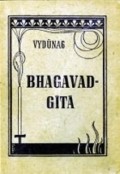 Original language:
Sanskrit
Original language:
Sanskrit Translated from: German and English
Authors: Veda Vyasa
Translated by: Vydunas
Full translated source bibliographical description:
Prof. Dr. P. Deussen'o Der Gesang des Heiligen, Leipzig 1911,
Dr. Franz Hartmann'o Die Bhagavad Gita, Das Lied der Gottheit, Braunschweig 1897,
Theodor Springmanno Bhagavad Gita, Der Gesang des Erhabenen, Lauenburg-Elbe 1921,
K. O. Schmidt, Bhagavad Gita, Das Hohe Lied der Tat, Baum-Verlag, Pfullingen 1940,
Annie Besant and Bhagavan Das, The Bhagavad Gita, Adyar-Madras, India 1926.
Published in: Detmold
Published on: 1947
Publisher: (Lietuvių) Lietuvių skautų brolijos vadija
There are numerous opinions about the origins of written Vedas. One of the most popular suggests that it was Veda Vyasa who was first to write Vedas down. Until then, Vedas were passed through generations by oral reception. After finishing his work (4 Vedas), Veda-Vyasa was not fully satisfied and felt there is a lack in his work. As a result he then wrote Puranas – historical narrations, main of which is Mahabharata. Puranas were meant for less intelligent class of society. Bhagavad-Gita …is a part of Mahabharata. Due to it‘s philosophical/egsistential nature, Gita is classified as one of upanishadas (Gitopanishad). Gita is philosophical, religious book which has similar impact on people in India as Bible has on europians.
Gita was written down in Sanskrit – language where one word can have many different meanings. As a result of this and other reasons, Gita is interpreted in many different ways. Two main schools, that base their ideology on Gita, can be mentioned: impersonalists and personalists. Impersonalists (Mayavadis) explain that supreme substance, from which everything emanates, is all encompassing, eternal, impersonal Brahman. This Brahman has no qualities, it exists beyond creation. Personalists (Vaishnavas) believe that Krishna (one of the heroes of a book) is the supreme personality, God, from whom everything (including impersonal Brahman) emanates. Naturally there are other interpretations of Gita. It is thought that even Hitler read and practiced Gita in his colorful life.
Vydunas translated Gita from several German translations, all of which were predominated by impersonal interpretation. We will try to go through main egsistential/philosophical ideas of this book as seen by this school. Gita is the conversation between Krishna and Arjuna in a very difficult situation where fighter Arjuna has to fight in a world war against his own kinsmen, friends, teachers. As a result he becomes overwhelmed by compassion and weakness desiring to give up a battle. His friend and chariot driver Krishna tries to convince him to fight. This situation represents our own life where our body is a chariot in which we (worldly humanity) and driver (divinity, wisdom) sits. We command our driver in one way or another but he is not passive, he too gives us advices (we call that conscience). If we listen and follow conscience, our life becomes spiritual and meaningful. If we don‘t, our life becomes empty, dry, and we fall prey to animalistic patterns.
Krishna consistently explains essential laws of life to Arjuna. He explains that world is a temporary manifestation of Brahman which manifests it‘s variety and potentials through it. All elements of creation, including human beings, are expressions of that Brahman. Understanding this, a person no longer feels as being the center of universe or independant actor, but rather as a part of a whole having a role to play for the good of all and ultimately achieve liberation from the cycle of birth and death by merging into impersonal Brahman. This lifestyle and goal is mainly obstructed by persons desire to enjoy material pleasures of life and lack of faith in higher forces and meanings.
Krishna suggests variety of ways how a person can become perfect and achieve complete selflessness culminating in nirvana. Those paths are: karma-yoga, jnana-yoga, ashtanga-yoga, bhakti-yoga. Karma-yoga is characterised by selfless work according to one‘s nature, performance of one‘s duties without attachment to it‘s results. Jnana-yoga is a path of wisdom leading to renunciation of selfish activities or activities at all. Ashtanga-yoga is a path of complex meditation leading to complete isolation from outer world. Bhakti-yoga is a path of love to work, creation and other beings. Bhakti-yoga is very similar to karma-yoga but is affected by emotional spice. The ultimate goal of all these paths is nirvana – complete enlightment, bliss. If one achieves nirvana before death, he does not need to take birth again and suffer in this world.
Krishna also explains the components of universe (sankhya); the difference between soul and body; the nature of birth and death, reincarnation, destiny of a dead man; different gunas (qualities, natures) and how they affect people, transcendence of these gunas; time; God‘s appearance in this world; 4 castes of human beings as created by God; the necessity of balance in opposing aspects of life (such as eating and fasting) etc.
I hope that this brief overview of Gita will inspire reader to invest some time into it or even study this pearl of wisdom deeply. However, I would strongly recomend to get in touch with as many different interpretations of Gita as possible in order to get a better overall picture of it‘s existential ideas.
